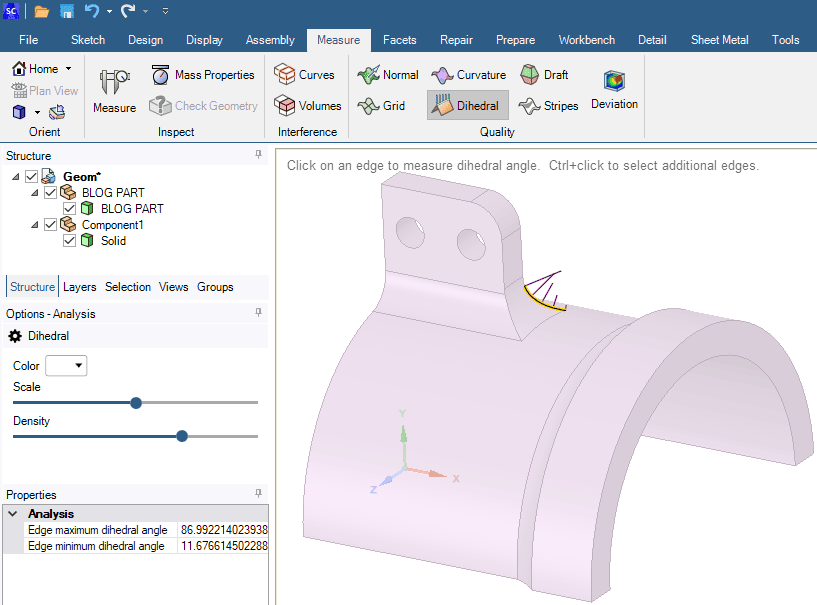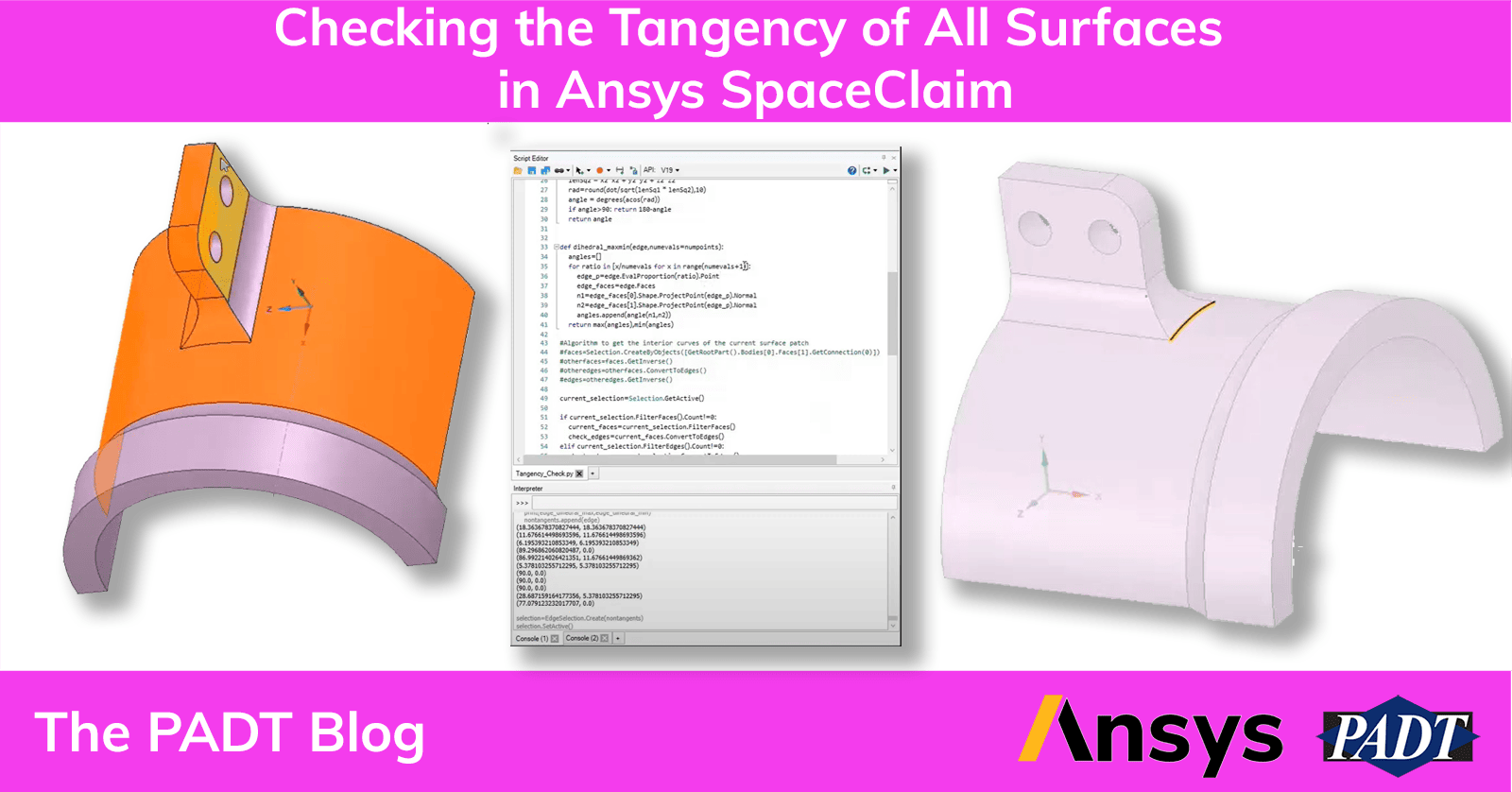The other day we got a tech support request wanting to know to check the tangency of all the surfaces in a model systematically in Ansys SpaceClaim. You can check surface tangency at an edge using the Measure > Dihedral tool. This measures the angle between the surfaces at a given number of points along the edge and returns the maximum and minimum values. If the surfaces are tangent, then the dihedral is zero. If not, scaled lines will show the dihedral values at the evaluated points.

This works great for a few edges, but checking the whole model would be quite tedious. So we turn to SpaceClaim Scripting. After checking the current scripting API and realizing that the dihedral calculation is not yet available, I wrote my own. You can download the script here. The script checks the dihedral value of each edge and returns the active set of the non-tangent edges. Since we would also have many edges that we already know are not tangent, like 90° angles, the script includes a cutoff angle of 40°. Only edges with a minimum dihedral below the cutoff angle will be selected.
# Python Script, API Version = V19
#############################################################
# tangency_check.py
# Select the geometry to check and then run the script
# Author: Joe Woodward
# Chief Engineer - Simulation Support
# Phoenix Analysis and Design technologies
# 1/31/2023
##############################################################
maximum_angle_cutoff=25 #Curves with a minimum angle larger than this will not be selected.
minimum_angle_cutoff=0 #1e-3 #Curves with a maximum angle smaller than this will not be selected.
numpoints=10 #Number of of curve evaluation points
print_edges=0 #Change to 1 to print max,min dihedral values for all non-tangent edges
#Selecting edges, or rerunning script with edges selected will also print the values.
from math import acos,sqrt,degrees
def angle(v1,v2):
x1,y1,z1=v1
x2,y2,z2=v2
lenSq1 = x1*x1 + y1*y1 + z1*z1
lenSq2 = x2*x2 + y2*y2 + z2*z2
dot = x1*x2 + y1*y2 + z1*z2 #between [x1, y1, z1] and [x2, y2, z2]
if lenSq1==0 or lenSq2==0:
#print("Normal has zero length",lenSq1,lenSq2)
return None
try:
rads=dot/sqrt(lenSq1 * lenSq2)
angle = degrees(acos(rads))
#print(dot,lenSq1,lenSq2,rads,angle)
except ValueError:
rads=round(dot/sqrt(lenSq1 * lenSq2),8)
angle = degrees(acos(rads))
#print("AgainAgain",dot,lenSq1,lenSq2,rads,angle)
except ZeroDivisionError:
print("ZeroRadians",dot,lenSq1,lenSq2)
if angle>90: return 180-angle
return angle
def dihedral_maxmin(edge,numevals=numpoints,problems=[]):
angles=[]
for ratio in [x*1.0/numevals for x in range(numevals+1)]:
edge_p=edge.EvalProportion(ratio).Point
edge_faces=edge.Faces
n1=edge_faces[0].Shape.ProjectPoint(edge_p).Normal
n2=edge_faces[1].Shape.ProjectPoint(edge_p).Normal
ang1=angle(n1,n2)
if ang1==None:
print("Normal has zero length at ratio %4.2f"%ratio,n1,n2)
problems.append(edge)
return None,None
angles.append(ang1)
return max(angles),min(angles)
#Algorithm to get the interior curves of the current surface patch
#faces=Selection.CreateByObjects([GetRootPart().Bodies[0].Faces[1].GetConnection(0)])
#otherfaces=faces.GetInverse()
#otheredges=otherfaces.ConvertToEdges()
#edges=otheredges.GetInverse()
#Check current selection for geometry types.
current_selection=Selection.GetActive()
if current_selection.FilterFaces().Count!=0:
current_faces=current_selection.FilterFaces()
check_edges=current_faces.ConvertToEdges()
elif current_selection.FilterEdges().Count!=0:
check_edges=current_selection.ConvertToEdges()
print_edges=1 #If only edges are picked, then print the dihedrals
elif current_selection.FilterBodies().Count!=0:
current_bodies=current_selection.FilterBodies()
check_edges=current_bodies.ConvertToEdges()
elif current_selection.FilterComponents().Count!=0:
check_edges=current_selection.ConvertToEdges()
else:
bodies=BodySelection.Create(GetRootPart().GetAllBodies())
all_faces=bodies.ConvertToFaces()
all_edges=all_faces.ConvertToEdges()
check_edges=all_faces.ConvertToEdges()
start_count=check_edges.Count
nontangents=[]
problems=[]
for edge in check_edges.Edges:
#esel=EdgeSelection.Create(edge) #Uncomment these lines to see the lines
#esel.SetActive() #as they are checked.
edge_dihedral_max,edge_dihedral_min=dihedral_maxmin(edge,problems=problems)
if edge_dihedral_max==None:
continue
if edge_dihedral_min>=maximum_angle_cutoff:continue
if edge_dihedral_max<=minimum_angle_cutoff:continue
if print_edges==1:
print(edge_dihedral_max,edge_dihedral_min)
nontangents.append(edge)
nontangent_selection=EdgeSelection.Create(nontangents)
nontangent_selection.SetActive()
print("%d edges processed. %d edges have dihedrals between %f and %f degrees."%(start_count,len(nontangents),minimum_angle_cutoff,maximum_angle_cutoff))
if print_edges==0:
print("NonTangent edges are now selected. Rerun the script to print the maximum,minimum dihedrals for those edges.")
if len(problems)>0:
print("The script had problems with %d edges. They should now be highlighted in blue."%len(problems))
problemSelection=EdgeSelection.Create(problems)
problemSelection.SetActiveSecondary()
Here is the file for download:
I was writing this for the customer in Ansys SpaceClaim 2020R2, which does not import numpy, so I had to write my own angle calculation function. I am happy to report, though, that SpaceClaim 2023R1 does import numpy, so now all of its amazing functions can be used.
Video Showing how to Check Tangency in Ansys SpaceClaim
Here is a quick video explaining the script and how to attach the script to your Toolbar for quick use whenever it’s needed.



















